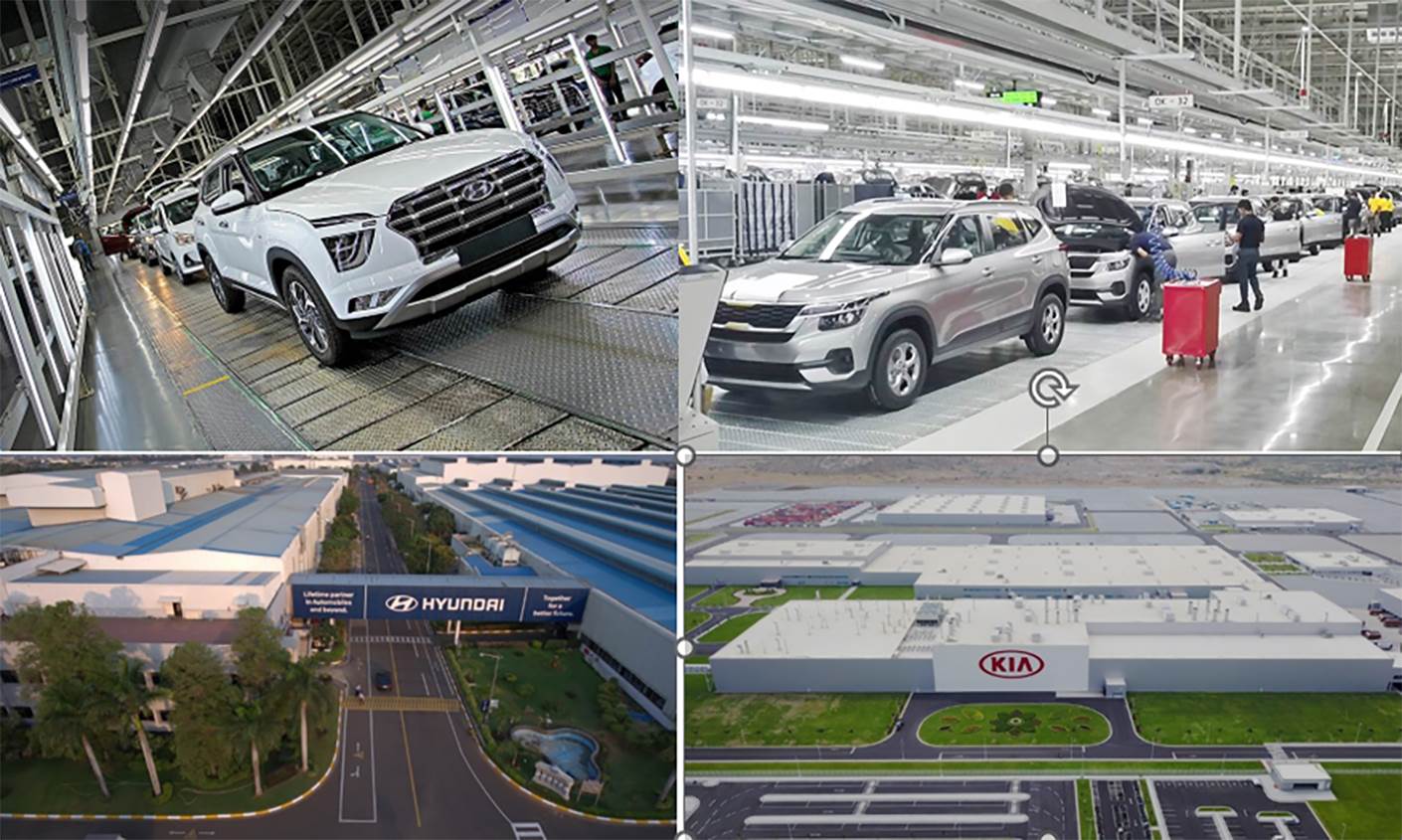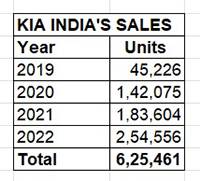Calendar year 2022 has been a record breaker in more ways than one for India’s passenger vehicle (PV) industry, not only because it has scaled a new high at over 3.8 million units, beating the previous best of 3.34 million units in 2018 but some carmakers have also notched their best-ever annual numbers since they began manufacturing and selling cars in the country.
Most PV manufacturers have raced into 2023 on a strong footing. Sixteen car manufacturers, the bulk of whom released their December 2022 wholesales numbers over the past two days, have recorded cumulative sales of 37.91,683 units, which constitute strong 25% year-on-year growth (CY2021: 30,35,662 units). Add sales of around 35,000 units from luxury carmakers in India to the cumulative sales total in the data table below and the 3.8-million-unit sales mark is surpassed.
The top six players – Maruti Suzuki, Hyundai Motor India, Tata Motors, Mahindra & Mahindra, Kia India and Toyota Kirloskar Motor – together account for 90% of the total PV market. Other than Hyundai and Toyota, which have seen year-on-year sales increases in single-digit percentage terms, in comparison the other four have posted double-digit gains. What’s common to all is that their growth can be credited to the surging demand for UVs and SUVs. While three OEMs – Tata Motors, Mahindra and Kia – have gained market share, the other three – Maruti, Hyundai and Toyota – have shed share in CY2022 when compared to their market performance in CY2021.
Let’s take a closer look at each of these carmakers and how they fared
Maruti Suzuki India: 15,76,025 units / up 15%
CY2022 PV market share: 41.68%, down from 2021’s 44.79%
Passenger vehicle market leader Maruti Suzuki sold over 1.5 million units to record 15% YoY growth in CY2022. The bulk of its growth came from its compact models – the Baleno, Swift, Wagon R, Celerio, Ignis, Dzire (and Tour S) – which with 869,040 units accounted for 55% of its sales in CY2022 compared to 52% in CY2021. Its UVs with 337,157 units contributed 21% to total sales last year, the same as in CY2021.
Its entry level models – the Alto and S-Presso – with 227,824 units contributed 14.45% to PV sales in 2022 but flagging demand in this mass-market segment meant that this was a decline over the 17% in 2021.
The carmaker, which has a pending order backlog of an estimated 375,000 units, would have fared better had production not been impacted at different times during the year due to the semiconductor supply chain issue. In fact, its December 2022’s tally of 112,110 units the lowest in the year, caused by what the company said, ““The shortage of electronic components had some impact on the production of vehicles, mainly in domestic models.” In 2022, September with 138,380 units, was the best month for Maruti Suzuki.
Hyundai Motor India: 552,511 units, up 9%
CY2022 PV market share: 14.57%, down from 2021’s 16.65%
Hyundai Motor India has entered 2023 on a strong note, having closed 2022 with its best-ever domestic market annual sales – 552,511 units / up 9.4% — since began manufacturing operations 25 years ago in September 1998.
The monthly sales average works out to 46,042 units for the Korean carmaker which currently retails nine passenger vehicles comprising five SUVs (Creta, Venue, Alcazar, Tucson and Kona), two hatchbacks (i10 Grand, i20 Elite) and the Xcent/Aura sedans.
Hyundai’s strong performance is thanks to sustained demand for two of its best-selling products – the Creta midsize SUV and the Venue compact SUV. The Creta, India’s No. 2 best-selling SUV after the Tata Nexon, has sold a total of 140,895 units and accounts for 25.50% of total sales.
The Venue, with estimated 12-month sales of 121,918 units contributed 22% to Hyundai’s record sales in 2022. Combined Creta-Venue sales account for an estimated 47% of total Hyundai sales, which see SUVs contributing to over 50% to the overall number.
Till end-December 2022, the Creta is estimated to have sold a total of 823,260 units, having crossed the cumulative 800,000-unit sales milestone in November 2022, within 8 years or 89 months after launch. Combined with exports, the Creta has recorded over a million sales since launch in July 2015.
Tata Motors: 526,798 units / up 59%
CY2022 PV market share: 13.89%, up from 2021’s 10.90%
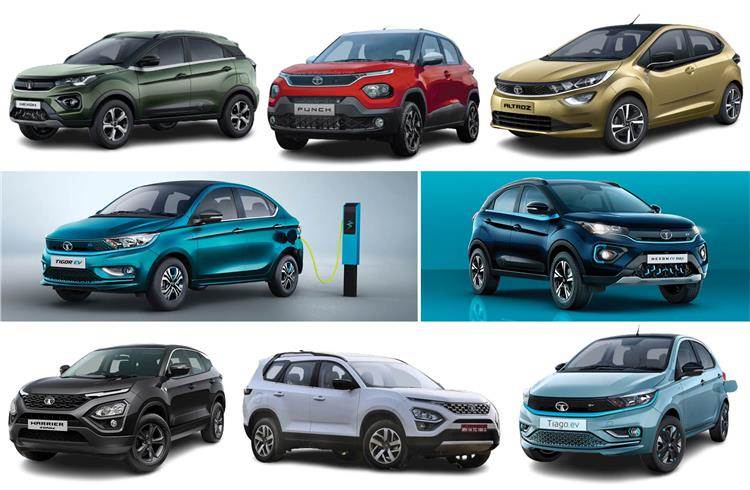
What has also helped Tata Motors’ accelerated growth is its first-mover advantage in the fast-growing electric vehicle market, where it has an over 80% market share. The company currently retails the Nexon EV, Tigor EV and Xpres-T (for fleet buyers) and has also recently launched the Tiago EV, whose deliveries are to begin in January. As per Autocar Professional’s estimates, Tata Motors has sold 41,538 EVs in CY2022, which accounts for 7.88% of the company’s total sales of 526,798 units. Year on year, the company has recorded 59% growth (see data table below).
With strong 59% YoY growth, Tata Motors has also made the maximum gains in PV market share which has increased by 3 percentage points to 13.89 from 10.90 in CY2021. The company is eyeing the No. 2 position and closed CY2022 with just 25,713 units behind Hyundai Motor India. The battle between these two carmakers for second spot in India’s booming PV market now moves into 2023 which will see them roll out new models.
Mahindra & Mahindra: 335,088 units / up 65%
2022 PV market share: 8.83%, up from 2021’s 6.70%
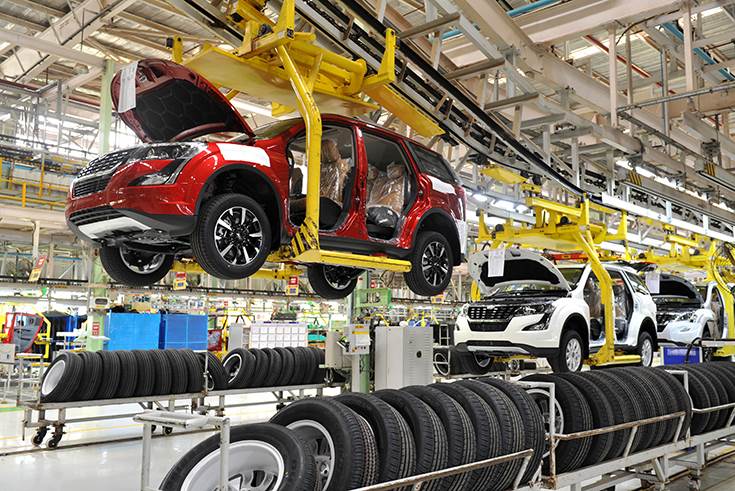
The robust growth can be seen in the smart increase in average monthly sales of 27,924 units in 2022 versus the 16,949 units in 2021. The numbers could have been considerably higher if it weren’t for production being impacted by the vexing semiconductor supply chain issue, which refuses to bow out.
At the beginning of November, M&M’s order bank of 260,000 units comprised the Scorpio N and Scorpio Classic (130,000 units), XUV700 (80,000 units), Thar (20,000 units), Bolero and Bolero Neo (13,000 units) and the XUV300 (13,000 units). To ensure increased supplies to dealers and consumers, the company has announced an aggressive manufacturing capacity expansion programme, designed to increase production by 68% to over 600,000 units per annum over the next 12-15 months. This will see the monthly output grow from 29,000 units in Q4 FY2022 to 49,000 units by January-March 2024 (Q4 FY2024).
Kia India: 254,556 units / up 40%
CY2022 PV market share: 6.71%, up from 2021’s 5.98%
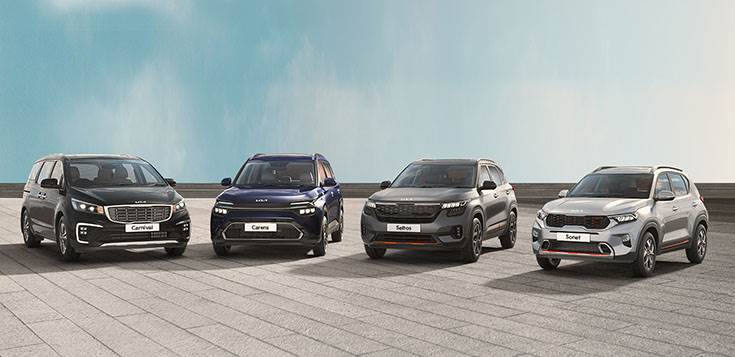
Kia’s growth has been bolstered by the fact that it has a UV-strong portfolio. The Seltos midsize SUV, its best-selling product, sold 101,569 units, accounting for 40% of total sales. The compact Sonet SUV with 86,251 units contributed 34% and the Carens MPV packed quite a punch with 62,756 units in its first full year of sales. Given the sustained demand for these three Kias, it is not surprising that they are regulars in the India Top 10 UVs list. Meanwhile, adding to Kia’s overall numbers, the Carnival MPV and the all-electric EV6 sold 3,550 and 430 units, respectively in 2022.
Commenting on Kia’s robust performance, Hardeep Singh Brar, VP and Head (Sales & Marketing), Kia India said, “CY2022 has turned out to be the best-ever year for Kia India. Despite various headwinds like geopolitical issues, Covid-induced supply chain obstructions and price increase, we managed to register the highest sales ever for the brand in the country. It is a matter of great pride that Kia products are not only disrupting their respective segments in India but also creating waves and ever-growing demand in the international markets.”
Toyota Kirloskar Motor: 160,357 units / up 23%
CY2022 PV market share: 4.22%, down from 2021’s 4.30%
Toyota Kirloskar Motor reported its total wholesales for calendar year 2022 at 160,357 units. This is the company’s highest-ever wholesales in the past 10 years and a 23% year-on-year growth (CY2021: 130,768 units). The best ever wholesales earlier clocked by TKM was in 2012 with a total of 172,241 units. In December 2022, TKM sold 10,421 units, down 4% on the year-ago 10,834 units.
Atul Sood, Associate Vice President, Sales and Strategic Marketing, TKM said, “The year 2022 has been tremendous for TKM, both in terms of new product launches as well as sales performance. We introduced milestone models like the Urban Cruiser Hyryder and the Innova Hycross. Some of our other launches earlier this year, like the new Glanza, are also doing extremely well. TKM’s flagship models like the Fortuner, Legender, Camry & the Vellfire, continue to excel in their respective segments.”
Other beneficiaries of the overall market growth last year have been Honda Cars India, Skoda Auto India, MG Motor India and Volkswagen India. Honda sold a total of 95,022 units, up 7% YoY with the City sedan seeing good traction. Skoda and Volkswagen have both benefited from the VW Group’s India 2.0 programme-derived new models. Skoda India saw its sales jump 125% to 53,721 units, its best-ever calendar year numbers, thanks to demand for the Kushaq SUV and the Slavia sedan. This has seen Skoda’s PV market share grow to 1.41% from 0.78% in CY2021. Likewise, Volkswagen India, powered by demand for its Taigun SUV and Virtus sedan, saw sales rise 58% to 42,481 units, resulting in a market share increase to 1.12% from 0.88% a year ago. MG Motor India, with 48,063 units, registered 19% YoY growth.

With a year as good as 2022, can CY2023 be better? If that is to be, then carmakers in India will have record average monthly sales of over 316,666 units for all of this year. Somewhat challenging but given OEM plans to introduce a number of new products – most of them SUVs and some electric – the new year should be an exciting one.
With the PV industry having pending orders of an estimated 550,000 units, most of the top carmakers have ramped up production to ensure smoother deliveries to their dealers and customers. What is also a fact is that despite inflationary trends and rising interest costs, demand is not slowing down and the SUV boom is continuing to boom. SUVs now account for nearly one out of every two cars sold in India. All OEMs, with a strong and fresh SUV product portfolio are firing on all cylinders. While the compact SUV segment remains high on the consumer radar, the growing demand for midsize SUVs is apparent. Meanwhile, there is also a smart uptick for executive sedans.
The electric vehicle segment will also be adding to the growth curve, particularly from January 2023 when the Mahindra XUV400, the first real rival to the EV leader Tata Nexon, will be released. The month will also see the rollout of the Tata Tiago EV as well as the premium Byd Atto 3 SUV. And there will be plenty more new cars in the months after January.
Clearly, it’s an exciting time out there in India’s booming passenger vehicle market. Keep watching this space


